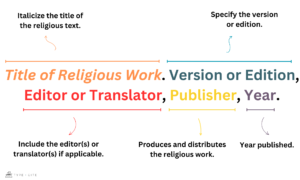How to Cite Religious Works in MLA
- Tomas Elliott (Ph.D.)
- Published on 05/16/2024
Religious texts hold significant importance across various cultures and societies, serving as guiding principles for millions of individuals worldwide. When incorporating excerpts or references from these texts into academic or scholarly writing, it is essential to cite them accurately to give proper credit to the source. In accordance with the Modern Language Association (MLA) style, citing religious works such as the Bible, Qur’an, or Talmud follows a specific format to maintain consistency and clarity.
CITATION ELEMENTS OF RELIGIOUS WORKS
- Name of Religious Work: This refers to the title of the specific religious text you are citing which should be italicized. For example, if you are citing the Christian Bible, you would include its title, The Bible. Similarly, if you are citing the Islamic holy book, it would be “The Holy Qur’an,” and for the Jewish text, it might be “The Talmud.”
- Version or Edition: This indicates the particular version or edition of the religious work you are citing. Different versions may exist due to translations, interpretations, or revisions.
- Editor: If the religious work has been edited, this element includes the name of the editor(s). Editors are individuals who compile, arrange, or annotate the text. Include the first and last names of the editor, if available.
- Translator: If the religious work has been translated from its original language, this element includes the name of the translator(s). Translators are individuals who render the text into another language while preserving its meaning. Include the first and last names of the translator, if available.
- Publisher: This refers to the entity responsible for producing and distributing the specific edition of the religious work. It could be a publishing company, a religious organization, or an academic institution.
- Year of Publication: This indicates the year when the specific edition of the religious work was published. It provides important contextual information for readers and scholars.
HOW TO CITE THE BIBLE
| Citation |
The New Jerusalem Bible. Edited by Henry Wansbrough, Doubleday, 1985.
|
| Structure |
Title of the Bible. Edited by Editor’s First Name Last Name, Publisher, Year of Publication.
|
In this example, The New Jerusalem Bible is the title of the Bible, Henry Wansbrough is the general editor, Doubleday is the publisher, and 1985 is the year of publication.
In-Text Citation Example
| Example | (The New Jerusalem Bible, John 3.16) |
| Structure | (Title, Book Chapter.Verse) |
This citation shows a quote from the Bible, specifically from The New Jerusalem Bible, in John 3.16.
HOW TO CITE THE QUR’AN
| Citation |
The Holy Qur’an. Translated by Abdullah Yusuf Ali, Tahrike Tarsile Qur’an, 1987.
|
| Structure |
Title of the Qur’an. Translated by Translator’s First Name Last Name, Publisher, Year of Publication.
|
In this instance, The Holy Qur’an is italicized as the title, Abdullah Yusuf Ali is the translator, Tahrike Tarsile Qur’an is the publisher, and 1987 is the year of publication.
In-Text Citation Example
| Example | (The Holy Qur’an, Al-Baqarah 2.255) |
| Structure | (Title, Surah Name Surah.Verse) |
This citation refers to a verse from the Qur’an, Surah Al-Baqarah (2), verse 255.
HOW TO CITE THE TALMUD
| Citation |
The Babylonian Talmud. Edited by Isidore Epstein, Soncino Press, 1935.
|
| Structure |
Title of the Talmud. Edited by Editor’s First Name Last Name, Publisher, Year of Publication.
|
Here, The Babylonian Talmud is the title, Isidore Epstein is the editor, Soncino Press is the publisher, and 1935 is the year of publication.
In-Text Citation Example
| Example | (The Babylonian Talmud, Baba Metzia 59b) |
| Structure | (Title, Tractate Page Side) |
This indicates a passage from The Babylonian Talmud, specifically from Baba Metzia, page 59b.
 |
Include Relevant Details: When citing religious works, it’s crucial to provide comprehensive information, including the complete title, any subtitles, and details about the version or edition, such as the King James Version or New International Version of the Bible. This ensures specificity and clarity in identifying the exact text being referenced. No Page Numbers: Unlike standard citations, which often include page numbers, citing religious texts typically omits this detail due to their diverse structures. Instead, reference the specific chapter, verse, or section relevant to the citation, accommodating the varied organization of religious texts while ensuring accuracy in referencing. Abbreviations: When citing passages from books of scripture in your writing, it’s common practice to abbreviate the titles for in-text citations. For instance, “Genesis” becomes “Gen.”, “Exodus” becomes “Ex.”, “Matthew” becomes “Matt.”, and so on. Using abbreviations not only saves space but also maintains a consistent and concise citation style throughout your work. Always ensure that the abbreviation you use is widely recognized and understood within the academic or religious context you’re writing in. |
GIVE YOUR CITATIONS A BOOST TODAY
Start your TypeCite Boost 3 day free trial today. Then just $4.99 per month to save your citations, organize in projects, and much more.
SIGN UP